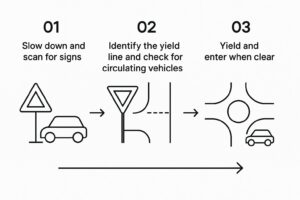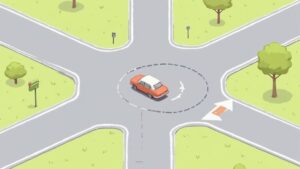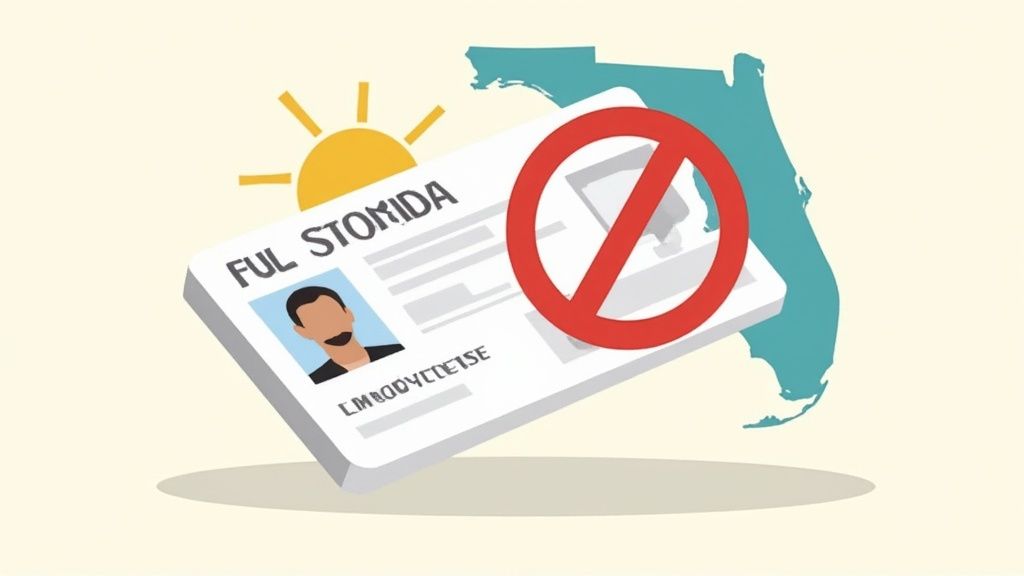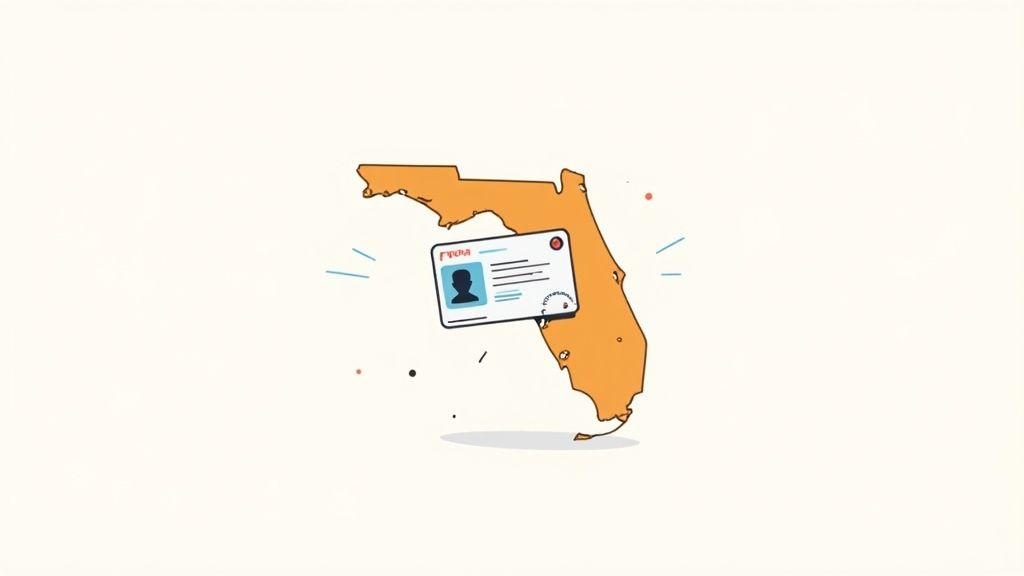Learning how to navigate roundabouts boils down to a few key actions: slow down, yield to the cars already circulating, and know which lane you need before you get there. Stick to these golden rules, and you’ll find they’re much less intimidating than they seem.
Why Roundabouts Feel Tricky (But Are Actually Safer)

If you feel a little nervous approaching a roundabout, you’re in good company. For most of us raised on stop signs and traffic lights, the constant, flowing traffic of a circular intersection can look like organized chaos. That initial uncertainty, though, usually comes from a lack of experience, not any real danger. The truth is, roundabouts are engineered from the ground up to be significantly safer than the intersections you’re used to.
The secret to their success isn’t magic; it’s smart design.
- Slower Speeds are Built-In: The gentle curve of a roundabout forces everyone to slow down, usually to between 15-25 mph. Driving slower gives you more time to react and drastically reduces the severity of any potential collision.
- The Most Dangerous Crashes Disappear: Roundabouts are brilliant because they eliminate the possibility of high-speed, T-bone (right-angle) and head-on collisions—the most lethal types of crashes at traditional four-way intersections.
- Your Job is Simpler: Instead of frantically scanning for traffic from all directions, you only need to focus on one thing: looking to your left for a safe gap to merge.
The Numbers Don’t Lie
The safety data is pretty compelling. A major study from the Insurance Institute for Highway Safety (IIHS) found that when traditional intersections were converted to roundabouts, total vehicle collisions fell by 39%. What’s even more remarkable is that injury-causing crashes plummeted by 76%, and fatal accidents were reduced by an incredible 90%.
By forcing lower speeds and getting rid of risky left turns across oncoming traffic, roundabouts essentially design the most dangerous human errors right out of the intersection.
Of course, navigating any intersection safely starts long before you arrive. It’s part of a broader commitment to responsible driving, which includes making sure your vehicle is up to the task. Before heading out, you should always ensure your brakes are in top condition for safe driving.
Grasping these core safety ideas is the first step to becoming confident with roundabouts. For more on the foundational rules of the road, our guide to Florida traffic safety for all drivers provides excellent tips that are useful no matter where you drive.
Approaching a Roundabout Like a Pro
Successfully navigating a roundabout starts long before you ever get to the entry point. What you do in those last few hundred feet makes all the difference between a smooth, confident merge and a jerky, stressful stop. Your first heads-up is usually a circular yellow warning sign—that’s your signal to start slowing down and preparing.
As you close the distance, you’ll see black-and-white signs with a diagram of the roundabout’s layout. Pay close attention. These signs are your roadmap, showing you exactly which lane to be in for where you want to go, whether you’re hanging a right, heading straight through, or making a left turn. Getting into the correct lane early is probably the single most important thing you can do.
Reading the Road Ahead
Once you’re in the right lane, your attention needs to shift to the traffic already flowing within the circle. Don’t just stare at the bumper of the car in front of you; look through the roundabout to get a feel for the speed and spacing of the vehicles. This kind of forward-thinking is a cornerstone of safe driving, and you can dive deeper into similar strategies with these defensive driving techniques.
When you anticipate the movement of cars already in the roundabout, you can spot your opening before it even gets to you. This helps you avoid those hurried, last-second decisions that cause problems for everyone on the road.
The infographic below shows this process perfectly.

Think of it as a sequence of deliberate actions, not just one decision you make at the yield line. By slowing down, scanning ahead, and picking your spot early, you set yourself up for a seamless entry.
The real art of the roundabout is timing your arrival at the yield line to meet an open gap, letting you merge without ever coming to a complete stop. Keeping things moving is what makes them so efficient.
Picking the Right Lane (When There’s More Than One)
Multi-lane roundabouts can feel a little more complex, but the logic is simple. Choosing the right lane from the get-go prevents you from having to make awkward or dangerous lane changes inside the circle.
Use this quick guide to select the right lane as you approach a roundabout, based on which exit you plan to take.
| Your Intended Exit | Recommended Lane (Multi-Lane Roundabout) | Signaling Advice |
|---|---|---|
| First Exit (Right Turn) | Right Lane | Signal right as you approach and keep it on until you exit. |
| Second Exit (Straight Through) | Right or Left Lane (check road signs for specifics) | Do not signal on approach. Signal right just after you pass the first exit. |
| Third Exit or Beyond (Left Turn/U-Turn) | Left Lane | Signal left as you approach. Switch to your right signal just after you pass the exit before yours. |
Mastering this lane choice is a huge confidence booster. When in doubt, always follow the specific instructions on the road signs, as some roundabouts have unique configurations.
As you get ready to enter, keep these final actions top of mind:
- Slow down to a manageable 15-20 mph. This gives you time to react.
- Look for pedestrians and cyclists at the crosswalks. They have the right of way.
- Glance in your mirrors to stay aware of what drivers around you are doing.
Mastering the Art of Yielding and Entering

This is it—the moment that seems to trip everyone up. Deciding when to actually merge into the circulating traffic can feel intimidating, but the number one rule is incredibly simple: you must yield to all traffic already inside the circle.
Think of it just like merging onto a freeway. You wouldn’t just pull out and hope for the best. Instead, you wait for a safe, clear gap to appear. Cars already in the roundabout have the right-of-way, period. Your job is to look left, judge the flow, and merge smoothly when you see your opening. A rushed decision here is almost always the wrong one.
Understanding the core principles of yielding is a huge part of being a confident driver. If you’re ever unsure about these situations, brushing up on who has right of way can make a real difference.
Judging the Gap and Making Your Move
Spotting a safe gap is a skill, and like any skill, it gets much easier with practice. You’re looking for a space between cars that’s big enough for you to enter and get up to speed without forcing the driver coming up behind you to slam on their brakes. That’s the key.
A common mistake I see is drivers fixating only on the very next car. Try to look further into the roundabout. This gives you a much better preview of the spacing and helps you time your entry for a smooth, rolling merge instead of coming to a dead stop.
The core principle here is patience. Never let the car behind you pressure you into going. Wait for a gap that you are 100% comfortable with before you even think about hitting the gas.
Don’t Forget Pedestrians and Cyclists
Before you even start looking for a gap in traffic, your first glance should always be at the crosswalks right at the entrance. Pedestrians and cyclists crossing there always have the right-of-way. Make it a habit to stop for them before you even get to the yield line. It’s a critical safety step.
This whole process of yielding is exactly why roundabouts are so much safer than traditional intersections. They’re designed to slow everyone down and simplify decisions. In fact, studies show a standard four-way intersection has 32 potential collision points. A roundabout? Just eight. This design nearly eliminates the most dangerous types of crashes, like T-bones and high-speed left turns. It’s a smarter, safer way to manage traffic flow.
Driving Through and Exiting Smoothly
Okay, you’ve yielded correctly and merged into the flow of traffic. The hardest part is over. Now, your focus shifts to keeping things smooth and predictable for everyone around you.
The key here is maintaining a steady speed, usually somewhere between 15 and 25 mph. You want to move with the traffic, not against it. Avoid sudden braking or accelerating, as that can throw off the rhythm that makes roundabouts work so well.
And whatever you do, never stop inside the roundabout itself. The only exceptions are if traffic ahead is completely stopped or you need to yield to an emergency vehicle. Otherwise, keep moving.
Signaling Your Exit the Right Way
This is where many drivers, even experienced ones, get it wrong. Signaling properly is what keeps the whole system flowing. You’re not just telling people behind you what you’re doing; you’re giving a heads-up to the drivers waiting to enter.
Think of it this way:
- Don’t signal as you enter the roundabout, unless you’re immediately taking the very first exit.
- Signal your exit by flicking on your right turn signal just after you pass the exit before the one you want.
That timing is crucial. It tells drivers waiting at the next entrance that a gap is about to open up, allowing them to enter confidently. It also prevents the driver behind you from having to slam on their brakes.
If you want to brush up on the nuances, our guide on when to use turn signals is a great resource. Clear communication is everything on the road.
Pro Tip: Missed your exit? It happens. The beauty of a roundabout is the built-in do-over. Don’t panic, don’t swerve, and definitely don’t stop. Just stay in your lane, drive around one more time, and get it right on the next pass. It’s a completely normal, safe way to correct a mistake.
Navigating Tricky Multi-Lane Roundabouts

Multi-lane roundabouts can feel intimidating at first glance, but the strategy is simpler than it looks: get in the correct lane before you enter, and then stay there. The single most dangerous thing you can do is try to change lanes mid-circle. It’s unpredictable, confusing, and a classic recipe for a sideswipe collision.
The lane you pick on approach determines your entire path. If you enter in the left lane, you exit from the left lane. Enter in the right, exit in the right. It’s best to think of the painted lines inside the roundabout as temporary walls that guide you straight to your exit.
The golden rule for multi-lane circles is this: Stay in your lane from entry to exit. If you suddenly realize you’re in the wrong lane, don’t panic. Just stay put, complete the circle, and try again on your next pass. It’s much safer than a last-second swerve.
This isn’t just about personal safety; it makes the entire intersection flow smoothly for everyone. And the data backs it up. Many European roundabout safety findings show that well-designed roundabouts are incredibly effective, even reducing pedestrian accidents by 75% because of slower speeds and shorter crossing distances.
Giving Large Vehicles Extra Space
The moment you see a semi-truck or a large bus entering a multi-lane roundabout, your defensive driving skills need to kick into high gear. These vehicles are long and have a massive turning radius, which means they simply can’t hug a single lane through the tight curve.
To avoid hitting the curb or the central island, they often need to straddle both lanes. This isn’t poor driving; it’s a physical necessity.
Here’s how to handle it:
- Never try to drive next to a large truck inside a roundabout. Just hang back and give it plenty of room.
- Be aware of “off-tracking,” where the trailer takes a much tighter path than the cab and can easily swing into your lane.
- Essentially, treat the truck as if it owns both lanes for the short time it’s in the circle.
Giving these larger vehicles the space they need is a small courtesy that prevents big accidents. You avoid getting squeezed out, and everyone gets through the intersection safely.
Clearing Up Roundabout Confusion
Even when you know the basics, certain situations in a roundabout can make you second-guess what to do. Let’s walk through a few of the most common tricky spots that drivers ask about. Getting these sorted will help you handle almost anything a roundabout throws your way.
An Emergency Vehicle is Approaching, What Now?
Seeing flashing lights or hearing a siren behind you can be stressful, and your reaction depends entirely on where you are.
- If you haven’t entered the roundabout yet: Don’t go in. Just pull over to the right and stop, exactly like you would on a normal road. Let the emergency vehicle pass before you proceed.
- If you’re already in the circle: This is the important part—do not stop inside the roundabout. Keep driving, take your intended exit, and then pull over to the right.
Stopping dead in the middle of a roundabout can completely block the emergency vehicle’s path and cause a dangerous, chaotic traffic jam. Your job is to clear the way, and that means exiting first.
Is It Ever Okay to Stop in a Roundabout?
The short answer is a hard no, with very few exceptions. The entire system is built on constant, flowing movement.
The only time you should ever stop is to avoid hitting the car right in front of you or, in a rare case, if an emergency vehicle is blocking your path inside the circle. Otherwise, you keep moving.
Think of it this way: all the yielding happens before you enter. Once you’re in the flow, you own the right-of-way over anyone trying to get in. Never, ever stop to be “nice” and let another car merge.
How Do I Navigate with Bicycles?
It’s simple: treat cyclists just like any other vehicle on the road.
If a cyclist is already circulating in the roundabout, you must yield to them before entering. Once you’re both in the roundabout, give them space and let them occupy the full lane. Do not try to squeeze past or overtake a cyclist within the circle—it’s incredibly dangerous. Always be on high alert for cyclists and pedestrians at the crosswalks leading into and out of the roundabout, as they have priority.
Feeling more confident? Keep your driving skills sharp and your record clean with our state-approved courses. BDISchool offers flexible, online driver improvement programs to help you stay safe on the road. Find out more about our courses.





